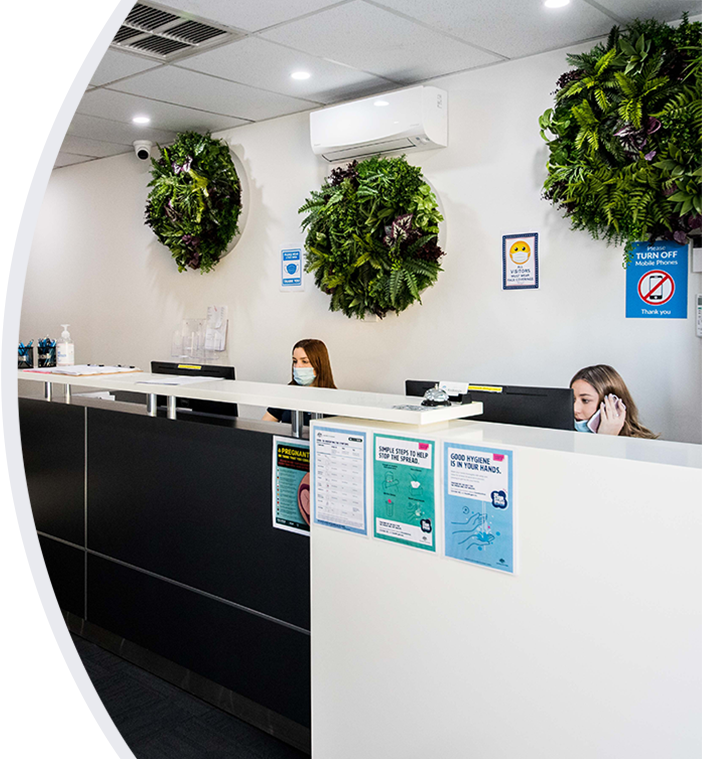Interventional Procedures
What is Interventional Radiology?
Interventional radiology is an area of medicine that specialises in using imaging and interventions to diagnose and manage diseases.
What are the types of interventional radiology procedures?
There are a number of interventional procedures performed at Vision Radiology. Ongoing advances in technology means that the list keeps growing and includes the following:
- Corticosteroid injections
- Local anaesthetic injection
- Platelet injections
How do I prepare for an interventional procedure?
Instructions specific to your procedure will be provided to you.
Please inform staff at the time of booking if you are taking any blood thinners or are allergic to anything.
If you have any previous scans, please bring these along to your appointment.
Wear comfortable, loose clothing to allow for easy access for the procedure.
List of procedures
CT
Facet joint injection
A facet joint injection is a treatment that aims to stop pain stemming from an arthritic or inflamed facet joint. This is achieved by injecting cortisone to reduce the inflammation and can provide pain relief from 3-6 months.
Epidural Injection
Epidural injections are performed to treat back pain, sciatica, or spinal canal stenosis. The aim is to reduce the pain by injecting cortisone within the epidural space. This commonly is performed in the lumbar spine.
Nerve root injection
Nerve root injections are commonly performed in patients who suffer from neurological symptoms such as radiculopathy or sciatica, pins and needles or numbness down the arms and legs. A cortisone injection helps reduce the inflammation in the rever root and will often reduce the pain.
Hydrodilation Injection
A hydrodilatation injection is commonly performed in patients with adhesive capsulitis also known as frozen shoulder. This is done by injecting a combination of local anesthetic, cortisone and saline solution into the glenohumeral joint. The aim of this is to improve range of movement and reduce overall pain.
Ultrasound
Joint injections
A joint injection is commonly performed in patients with inflammation of the joint, such as synovitis. By injecting local anesthetic followed by cortisone can provide pain relief and reduce the overall inflammation of the joint. This is commonly conducted in the hip, knee and shoulder joint.
Bursal Injections
A bursal injection is conducted by injecting local anesthetic followed by cortisone into the bursa space to reduce inflammation and provide relief for bursitis. This is most often done in the trochanteric bursa of the hip and the subacromial bursa of the shoulder but can also be performed in the bursa of the elbow and knee.
Ganglion and Baker cyst aspiration
Cysts are a collection of fluid. A ganglion cyst is a swelling seen over tendons and joints and a Baker’s cyst, also known as a popliteal cyst, is found behind the knee. Sometimes the cysts can become enlarged or painful. An aspiration procedure is done to remove fluid from these cysts.
Tendon sheath injections
A tendon sheath is a strong fibrous tissue that connects muscle to bone and when the muscle contracts, the sheath helps to bend the joint. In some conditions, the tendon sheath can become swollen and painful. A tendon sheath injection involves injecting steroid medication into the area to help relieve the pain and swelling and improve the range of movement of the joint.
Fine Needle Aspiration (FNA)
A fine needle aspiration is a type of biopsy in which a small needle is used to collect a sample of tissue from an area of concern. The tissue is then sent to the laboratory for further testing. FNAs are most often done on swellings or lumps under the skin and they are helpful in diagnosing what the underlying tissue contains, and in particular, to rule out cancer.
Core biopsy
A core biopsy involves using a hollow needle to collect a sample of tissue from an area of concerns. It is more invasive than an FNA as the needle is larger. The tissue sample is then sent to the laboratory for examination by a specialist. Core biopsies are helpful in diagnosing suspicious lumps and bumps and to rule out cancer.
Example Videos of procedures
Ultrasound Guided Subacromial Bursal Injection
Ultrasound Guided Plantar Fascia Cortisone injection with Nerve Root Block
CT Guided Nerve Root Injection
CT guided Epidural Injection
Ultrasound Guided Ganglion Cyst Aspiration

We offer accessible services by bulk billing almost all examinations and procedures. To find out more, visit our billing information page.
Complete our booking form and one of our friendly staff will contact you – it’s quick, and easy. Click on the below link and follow the simple steps. Remember to have your referral handy.


















